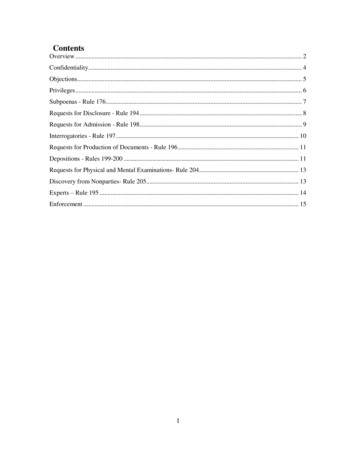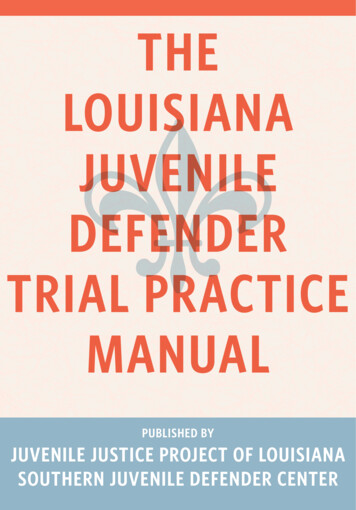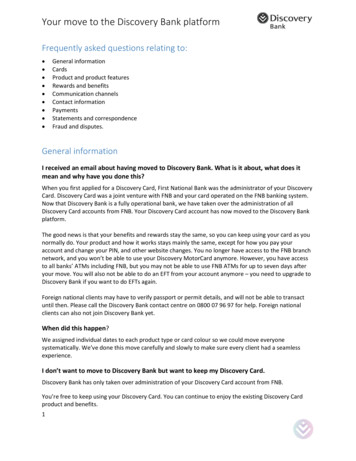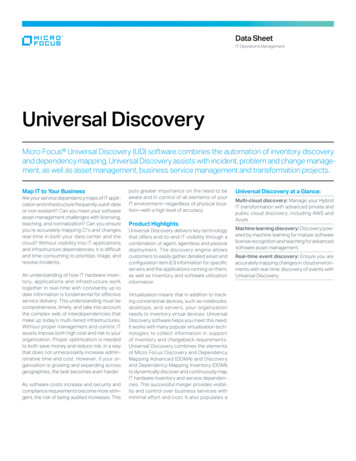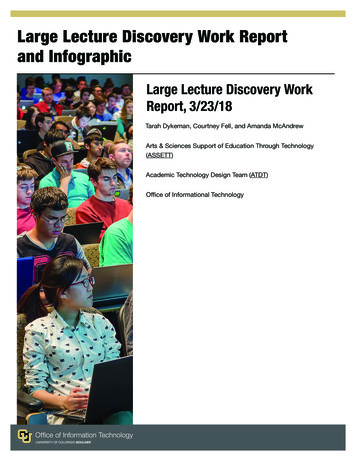
Transcription
Large Lecture Discovery Work Reportand InfographicLarge Lecture Discovery WorkReport, 3/23/18Tarah Dykeman, Courtney Fell, and Amanda McAndrewArts & Sciences Support of Education Through Technology(ASSETT)Academic Technology Design Team (ATDT)Office of Informational Technology
Table of ContentsProject Background . . . . . . . . . . . . . . . . . . . . . . . . . . . . . . . . . . . . . . . . . 3Project Plan. . . . . . . . . . . . . . . . . . . . . . . . . . . . . . . . . . . . . . . . . . . . . . . . 4Campus-Wide Student Survey. . . . . . . . . . . . . . . . . . . . . . . . . . . . . . . . . 4Campus-Wide Student Survey Results . . . . . . . . . . . . . . . . . . . . . . . . . . 5Engagement and Distraction . . . . . . . . . . . . . . . . . . . . . . . . . . . . . . . . . . 6Getting Help. . . . . . . . . . . . . . . . . . . . . . . . . . . . . . . . . . . . . . . . . . . . . . . . 9Improving Learning. . . . . . . . . . . . . . . . . . . . . . . . . . . . . . . . . . . . . . . . . 12Student Strategies for Improving Learning. . . . . . . . . . . . . . . . . . . . . . 14Large Lecture Infographic . . . . . . . . . . . . . . . . . . . . . . . . . . . . . . . . . . . 15Appendix A: Additional Survey Questions. . . . . . . . . . . . . . . . . . . . . . . 19Appendix B: Exploratory Survey Questions. . . . . . . . . . . . . . . . . . . . . . 26Appendix C: Accessible Survey Question Data . . . . . . . . . . . . . . . . . . . 29Appendix D: References and Additional Resources . . . . . . . . . . . . . . . 342
Project BackgroundWhy Large Lectures?GoalsLarge lecture courses are a staple of theundergraduate student experience at CU Boulder.While there is no standard for what constitutesa large lecture, based on campus practices thisdiscovery project defines large lectures as those with75 or more students enrolled.1. Learn student assumptions about large lecturecourses to better understand the reality andvariety of the large lecture student experience.Throughout their undergraduate academic career,CU students take an average of 14.5 large lecturecourses. This means that on average, 41% of ourstudents’ classroom experience is spent in a largelecture. Notably, students take most of these largelecture courses during their first and second yearsat CU: 53% of courses taken by freshmen are largelectures, and 54% of courses taken by sophomoresare large lectures. Furthermore, the average andmedian class sizes during a student’s undergraduateacademic career are 97 and 51, respectively.12. Develop resources and best practices for largelecture courses.How are students currently being engaged? Whatmethods work best for student engagement inlarge lecture classes?What strategies and resources can we provide tohelp students succeed in large lecture courses?What pedagogical recommendations can weprovide for instructors of large lecture courses?3. Better understand student preferences in largelecture courses.What structural changes could the universityconsider to better support all types of learners?A one-question survey posed to CU students inDecember 2016 found that 48% of students dislikelarge lecture courses, 34% like them, and 18% feelneutral.2 When asked what has helped students learnin large lectures, one student responded: “Nothing,it’s very distracting and hard to pay attentionbecause I feel I’m not as close to the professor.” TheATDT is utilizing research findings from the Spring2017 Large Lecture Discovery Work to inform ourcourse design work on campus and to providerecommendations and resources for facilitatingimproved large lecture experiences on the CUBoulder campus.1Original data from this section provided by CU’s Office of Data Analytics and is based on students from all majors and collegesgraduating with a bachelor’s degree in 2015-2016.2Numerous students reported liking large lecture courses due to the possibility of anonymity they offer.3
Project PlanThe following activities were conducted between fall 2016-spring 2018, and inform this final report. Theculmination of our discovery work was the May 2017 campus-wide student survey.1. Conduct research and gather resources on the large lecture student experience at CU Boulder.2. Plan research methods and a timeline for semester-long discovery work.3. Conduct campus-wide research through surveying and interviewing students: One-question survey shared with students across campus Student focus groups Canvassing students on campus with short iPad survey Campus-wide student survey (May 2017)4. Conduct observations of large lecture classes.5. Analyze research results and develop data visualizations.6. Provide OIT and the campus community with research results and suggestions or recommendations forimproving the large lecture student experience.Campus-Wide Student SurveyThis online survey was distributed via CU Boulder Today and OIT’s social media channels between May 3,2017 and June 1, 2017. 80 students completed the survey, with response numbers varying by question. Atthe end of the survey, students were able to provide their email address to participate in a random drawingfor a 10 Amazon gift card. The survey was comprised of 17 single answer, multiple choice, multiple select,and free response questions. Questions covered the topics of engagement and distraction, getting help, andimproving learning. The appendix of this report includes additional exploratory questions from the survey. Thefocal questions asked are as follows: Rate how often you are distracted during large lecture classes. What contributes to your being distracted during large lecture classes? What could instructors do to limit distractions in large lectures? What helps keep you focused in large lecture classes? How often do you typically attend office hours for a large lecture class? Why do you to go to office hours? What prevents you from attending office hours? (Select all that apply) What other ways do you get help in large lecture classes? Rate how helpful Clickers are to your learning in large lectures. What is most helpful about using Clickers? What is the coolest thing that has happened in a large lecture class that helped you learn? What have you done personally to improve your learning in large lecture classes?4
Campus-Wide Student Survey ResultsExecutive SummaryThroughout our discovery work surrounding large lecture courses on campus, we found that often studentshold a negative perception of the large lecture course format. This negative perception seems to be fueledby the challenges surrounding learning in large lecture courses, as revealed by this campus-wide studentsurvey. The most significant challenges for large lectures on campus relate to the ideas of distractionand engagement.While we recognize that students are at least sometimes distracted during classes, a key takeaway fromsurvey responses is that a combined 57% of students indicated that they are distracted half of thetime or more in large lecture courses. Student distraction is most often caused by factors that could bemitigated by direct, real-time intervention from instructors or teaching assistants. The top two causes ofdistraction stem from the behavior of other students in the classroom: 74% of students reported beingdistracted by other students talking, and 70% by other students’ screens/devices. Another significantchallenge students report in large lectures classes is difficulty hearing the instructor (51%) and seeinglecture materials and presentations (41%). These causes of student distraction could be addressed byinstructors’ improved use of classroom technology, such as mics and clearly visible presentation formats.Student suggestions for mitigating the distractions outlined above include instructors banning or limitingdevice use in the classroom. While students suggested banning devices or limiting their use to specificzones in the classroom, they also recognize the importance of supporting students with device-relatedaccommodation requirements. Additional suggestions included fostering student engagement with thecourse material through interesting lectures or presentations. The majority of students (93%) indicatedthat an “interesting instructor” improves their ability to stay focused in a large lecture course. Althoughthis is a rather vague concept, this data point highlights the importance of instructors intentionally designinglearning experiences that are engaging and connect with students. To improve engagement, studentsrecommended more facilitated interaction with instructors, TAs, and peers through active learning activitiesin classes (group discussion or work, effective Clicker use, facilitating study groups). The perceived lack ofconnection with instructors could be mitigated through instructors learning students names, providing moreopportunities for office hours (online, with TAs), and connecting lecture material to students’ lives.In addition to the above suggestions, the physical realities of large lecture classrooms merit furtherinvestigation. 34% of students indicated that they are distracted by background noises (such as noisefrom hallways). 41% of students indicated that classroom seating options are not ideal for engagedlearning. Seating arrangements in lecture halls on campus are often not easily accessible for large numbersof students, put most students at a distance from the instructor, and make it difficult to see and hear.We recommend sharing the results of this discovery work with the campus community to support instructorsin addressing issues surrounding distraction and engagement in large lecture courses. Some universities arepartnering with students and faculty to design a variety of large lecture classroom configurations that supportdifferent approaches to teaching and learning. We suggest CU Boulder review these models and considerimprovements to the large lecture experience.Large Lecture Discovery Work ArtifactsLarge Lecture Infographic (page 15) - infographic summary of survey dataLarge Lecture Classes: Tackling Distraction - tips for students and instructorsLarge Lecture Student Personas5
Engagement and DistractionStudent DistractionFour survey questions asked students about theirlevels of engagement and distraction in large lectureclasses taken on the CU Boulder campus. Whilewe recognize that students are at least sometimesdistracted during classes, a key takeaway fromsurvey responses is that a combined 57% ofstudents indicated that they are distracted halfof the time or more in large lecture courses(see “Figure 1”). Although we do not currently havedata on the rate of distraction in smaller classes oncampus, this high percentage of distracted studentswarrants some examination of best practices aroundstudent engagement.Rate how often you are distracted during largelecture classes:4% Never9% Always17% Most of the time39% Sometimes31% Half the timeLastly, 41% of students indicated that classroomseating options are distracting. After visiting largelecture halls on campus, we gained further insightinto issues surrounding classroom seating. Largelecture seats are often small, noisy, and groupedclosely together. The close proximity of seats makesit difficult to shift your position in class or to type ona computer without bumping into the person nextto you. More importantly, seating arrangementsoften prohibit students from walking in front ofseated students to access seats in the center of theclassroom. This results in a common sight on the CUBoulder campus: a dozen or more students sittingin the aisles of large lecture halls. Such a seriousclassroom seating challenge should be addressed byrelevant campus entities.“Figure 1: 80 students responded to this single answer multiplechoice question.Causes of Distractionpresentations in large classrooms. Observationsconducted in large lecture halls on campus revealedthat there are a range of factors causing thischallenge. In some cases, classroom AV technologygoes unused, in other cases, it is not being usedcorrectly. At times, current classroom technology isnot adequate to compete with other environmentalfactors, such as squeaking seats caused by studentsarriving late and noise from halls outside of theclassroom. 34% of students indicated that they aredistracted by noise from the hall, etc.Student distraction is most often caused by factorsthat could be mitigated by direct intervention fromthe instructor or teaching assistants (see “Figure2”). The top two causes of distraction stem from thebehavior of other students in the classroom: 74%of students reported being distracted by otherstudents talking, and 70% by other students’screens/devices. Although classroom managementoften does not receive much attention in highereducation, these findings suggest that instructorswould benefit from learning strategies to directlyaddress these challenges.What contributes to your being distracted during largelecture classes? (Select all that apply)74%Other students talkingOther causes of student distraction could begreatly mitigated by an improved use of classroomtechnology. 51% of students indicated that theyhave difficulty hearing the instructor, and 41% ofstudents struggle to see lecture materials and6
What could instructors do to limit distractions inlarge lectures?70%Other students’ screens51%Difficulty hearingBan/limitdevices49%Own screensInteresting/engaging lecturesImprovetechnology useEffectiveClicker useRemovedisruptive students41%Seating options41%Difficulty seeingClear audioInteractwith students34%Other (noise from hall, etc.)Figure 2: 76 students responded to this multipleselect question.Figure 3: 64 students responded to this free responsequestion. Responses were then categorized and counted.Counts can be found in Appendix C.Mitigating DistractionFigure 3 Sample Student Comments3An open-ended question asked students whatinstructors could do to alleviate distraction in largelecture classes, and 19 students suggested thatinstructors ban or limit device use. While studentssuggested banning devices or limiting their use tospecific zones in the classroom, they also recognizethe importance of supporting students with devicerelated accommodation requirements.Additional suggestions included fostering studentengagement with the course material throughinteresting lectures or presentations (see “Figure 3”).Sample student comments below provide furtherclarification. Students also suggested that effectivetechnology and Clicker use during lectures can limitdistraction, while employing classroom managementpractices, such as addressing disruptive students,would further support student learning.37 Ban laptops except for students that need themdue to disabilities. It worked really well in mypsych class. I hate it, but it really does help when they don’tallow computers or anything. Not sure maybe implementing a no electronicsrule, but in the end I doubt that would helpsince some students actually take notes ontheir computers. Make the lecture more interesting or personallyengaging. Probably talk to the board less. Make sure that they are always talking into a micand having computer sections on the sides and ano computer section in the middle. To overcome MENTAL distractions (or your mindwandering), I think clicker questions help, andalso working in small groups on problems. Be more engaging and also call people out if theyare being disruptive by talking, etc. If you’re notbeing quiet, they should be kicked out of class. Class interactions - calling on people in class tokeep them engaged. Walk around the room while lecturing andengaging with the students. Have more display screens across theclassroom to display presentation slides andlouder microphones.Sample student comments are representative of the variety of student responses to survey questions and illustrate particularlyinsightful student feedback.
Encouraging EngagementStudents were asked “What helps keep you focusedin large lecture classes?” and were provided withanswer choices based on results from a onequestion survey distributed to students in Fall 2016.The majority of students (93%) indicated that an“interesting instructor” improves their ability tostay focused in a large lecture course. Additionalfactors that encourage engagement and focusinclude the course subject or materials, the use ofdemonstrations or simulations in class, and effectiveClicker use (see “Figure 4”).Determining exactly what makes an instructor“interesting” is of course elusive and hard to achieveand reproduce. Students were also asked whatwas the “coolest” thing that has happened in theirlarge lecture courses on campus (see “Figure A1”and Figure A1 sample student comments). Thisinformation could be considered in determiningapproaches to being an “interesting” instructor.What helps keep you focused in large lecture classes?(Select all that apply)93% Interesting instructor65% Course subject/material59% Demonstrations/simulations55% Clickers33% Guest speakers31% PowerPoint presentations30% Videos23% Whole class discussion14% Group workFigure 4: 80 students responded to this multiple select question8
Getting HelpStudents responded to four questions about getting help in large lectures classes at the CU Boulder campus.While office hours attendance varies depending on student interest in the course subject, 61% of studentssurveyed reported that they either never attend office hours or attend only once a semester (see“Figure 5”). The remainder of students attend office hours from several times a semester to weekly. Themajority of students (83%) attend office hours to receive help in the class (see “Figure 6”). Just below halfof students attend office hours because they want to connect with the instructor or are interested in thesubject material.How often do you typically attend office hours for a large lecture class?35% Once a semester5% Other7% 4–6 times a semester9% Weekly18% 2–3 times a semester26% NeverFigure 5: 80 students responded to this single response multiple choice question.Why do you to go to office hours? (Select all that apply)Figure 6: 59 students responded to this multiple select question.9
A follow-up question displayed to students who indicated they “Never” attend office hours found that themost common reasons for not attending office hours were that the office hours timing did not fittheir schedule or that they did not feel comfortable speaking with the instructor (see “Figure 7”). Onestudent responded that “since the class is so large I feel the professor won’t know who I am or remember.”This statement is indicative of the importance for instructors to seem approachable to students and to formconnections with them.What prevents you from attending office hours? (Select all that apply)Figure 7: 20 students responded to this multiple select question posed to the 21 students that reported they “Never” attendoffice hours.A potential solution for making office hours more accommodating for students might be virtual office hours.When students were asked about their preferences for virtual office hours, 82% of students indicated thatthey might attend online office hours if offered (see “Figure A2”). Concerning the modality of online officehours, 41% of students would prefer instant messaging, and 40% a combination of video conferencing andinstant messaging (see “Figure A3”).Other Ways of Getting HelpThe majority of students also seek help in large lecture classes by asking a friend or TeachingAssistant (TA), followed closely by students utilizing online resources or attending a review session(see “Figure 8”). Some students indicated that they ask an undergraduate Learning Assistant (LA), use a studygroup, or ask an undergraduate Course Assistant (CA).44At CU, LAs and CAs are undergraduates that support teaching and learning in larger classes and receive varying degrees ofpedagogical training.10
What other ways do you get help in large lecture classes? (Select all that apply)Figure 8: 79 students responded to this multiple select question.11
Improving LearningStudents were asked four questions about what improves learning and Clicker use in large lecture courses.Responses show that 67% of students find Clickers to be very or somewhat helpful to their learning inlarge lecture courses (see “Figure 9”).Rate how helpful Clickers are to your learning in large lectures:Figure 9: 80 students responded to this single response multiple choice question.Clickers are helpful for student learning by checking for understanding, encouraging engagement, andreviewing material and preparing for exams (see “Figure 10”). Clickers are also helpful in providing instantfeedback to the instructor, encouraging further thought, reinforcing learning, encouraging group work anddiscussion, providing interaction, and answering questions. Based on student comments (see “Figure 10Sample Student Comments” below), it should be noted that effective Clicker questions, as well asenough time to answer Clicker questions, serve to improve student learning. Additionally, studentssuggested that instructors not use Clickers for predominantly attendance purposes. These responsesindicate that instructors could benefit from training on how to effectively implement Clickers inthe classroom.12
What is most helpful about using Clickers?Figure 10: 64 students responded to this free response question. Responses were then categorized and counted. Counts areincluded in the graphic above in addition to sample student comments from each category.Figure 10 Sample Student Comments5 They check my knowledge in real time or about things that I was supposed to read in preparation for theclass period. It keeps you focused, and is a fast way to see if you are learning the material or not before waiting forthe test. Keeps you engaged because you have to have been focused on the lecture before the Clicker questionsto know what’s going on. It’s a good idea of the kinds of questions that will be on the exam, and things we’re responsiblefor knowing. Immediate feedback about my understanding. Clickers are most helpful when they challenge me to retain or think further about the lecture material. Testing my knowledge and seeing where I need to learn more, for my use and the instructor’s use. I likewhen they are participation points, but not when it is a grade for what answer I chose since it is so quick. Makes you remember material better if you have to answer a question about it. Keeps students engaged, but I think Clickers should be a social, discussion based tool to get studentstalking about the questions in order to teach each other the material. Collaborating with other students to solve the problem.513Sample student comments are representative of the variety of student responses to survey questions and illustrate particularlyinsightful student feedback.
Student Strategies for Improving LearningStudents were asked about what they have done to improve their own learning in large lecture classes.Responses were grouped into four main categories: self-monitoring, independent learning, instructorrelated, and peer-related. Students reported self-monitoring behavior to improve their learning in largelecture classes that included sitting in the front of the classroom and avoiding or limiting technologyuse (see “Figure A4”). The independent learning behaviors that students reported to improve their learning inlarge lecture classes included taking notes (often handwritten notes) and reviewing their notes (see “FigureA5”). Instructor-related strategies included students asking questions and attending office hours (see “FigureA6”), while peer-related strategies included forming study groups (see “Figure A7”).14
The Student Experience in Large Lectures at CU BoulderClass size at CU53%54%38%28%1stYearAverage 972ndYear3rdYear424%thYear5thYearLarge lectures per course loadStudent satisfaction with recent large lectures“I don’t like how nonpersonal large lectures are.I learn much better when the professor knowsme and sees me every class.”18%Neutral48%Dislike34%LikeThis data was collected during 2016–17 from Institutional Research in CU’s Office of Data Analytics, two campus-wide surveys (n 120, n 80), canvassing students on campus, and a focus group.15
Contributors to student distraction“I hate to admit it, but it really does help whenprofessors don’t allow computers or anythingin class.”74%Other students talking70%Other students’ screens51%Difficulty hearing49%Own screens41%Seating options41%Difficulty seeing34%Other (noise from hall, etc.)This data was collected during 2016–17 from Institutional Research in CU’s Office of Data Analytics, two campus-wide surveys (n 120, n 80), canvassing students on campus, and a focus group.16
Frequency of distraction4% Never9% Always39% Sometimes17% Most of the time31% Half the timeStudent suggestions to reduce distractionsBan/limitdevicesInteresting/engaging lecturesEffectiveClicker useRemovedisruptive studentsImprovetechnology useClear audioInteractwith studentsThis data was collected during 2016–17 from Institutional Research in CU’s Office of Data Analytics, two campus-wide surveys (n 120, n 80), canvassing students on campus, and a focus group.17
Office hours attendance35% Once a semester5% Other7% 4–6 times a semester9% Weekly18% 2–3 times a semester26% Never“How good a large lecture class is really dependson the ability of the instructor to be engaging.”What keeps students focused93% Interesting instructor65% Course subject/material59% Demonstrations/simulations55% Clickers33% Guest speakers31% PowerPoint presentations30% Videos23% Whole class discussion14% Group workThis data was collected during 2016–17 from Institutional Research in CU’s Office of Data Analytics, two campus-wide surveys (n 120, n 80), canvassing students on campus, and a focus group.18
Appendix A: Additional Survey QuestionsWhat is the coolest thing that has happened in a large lecture class that helped you learn?Figure A1: 55 students responded to this free response question. Responses were then categorized and counted. Counts areincluded in the graphic above.Figure A1 Sample Student Comments6 Physics had a lot of awesome demonstrations that made conceptualizing the ideas easier. I had a professor connect every lecture to a popular song in some way. It was easier to remember thebroad scope of the learning in the class using these cues. An instructor used case studies as well as videos during the lecture. Periodically during class, we cluster in groups of 4 or 5 around white boards to collaboratively work onproblems. I guess white boards aren’t “the coolest thing,” but they are very helpful in learning and itwould be an easy thing for other profs to start using. A well-timed joke. When the lecturer emphasized that participation in clicker questions was important, but not getting thecorrect answer (e.g. class participation grade based on response rate rather than correct responses),students felt free to respond to clicker questions without fear of getting the answer wrong. When thisinitial question was followed by a period of discussing your answer with the students around you, peerto-peer instruction emerged organically and this often resulted in achieving a better understanding ofdifficult or tricky concepts. Demonstrations during chemistry or guest speakers. Watched movie clips that related directly to Freudian psychology.619Sample student comments are representative of the variety of student responses to survey questions and illustrate particularlyinsightful student feedback.
Todaysmeet.com. Everyone can type in their answers and read everyone else’s. And it can be anonymous.My Boccaccio teacher used it a lot. Recording video of each lecture, which I could re-check later (or watch if I had to miss a class). This wasan extremely valuable tool.If your instructor offered online office hours (video conferencing or instant messaging), would you attend?Figure A2: 80 students responded to this single response multiple choice question.20
Which would you prefer?Figure A3: 63 students responded to this single response multiple choice question.What have you done personally to improve your learning in large lecture classes?62 students responded to this free response question. Responses were then counted and grouped intofour main categories: self-monitoring, independent learning, instructor-related, and peer-related. Counts areincluded in the graphics below in addition to sample student comments from each category (see “FiguresA4-A7 Sample Student Comments”).21
Figure A4: Students reported self-monitoring behavior to improve their learning in large lecture classes that included sitting inthe front of the classroom, avoiding using technology, attending class, limiting technology use to taking notes, and not talking totheir peers.Figure A5: Students reported independent learning behavior to improve their learning in large lecture classes that included takingnotes, reviewing their notes, handwriting notes for class, printing out notes and lecture slides, and watching lecture capture.22
Figure A6: Students reported instructor-related behavior to improve their learning in large lecture classes that included askingquestions, going to office hours, and connecting with the instructor.Figure A7: Students reported peer-related behavior to improve their learning in large lecture classes that included connecting withtheir peers and forming study groups.23
Figures A4-A7 Sample Student Comments7 Make sure to sit closer to the front so I don’t get dist
Throughout our discovery work surrounding large lecture courses on campus, we found that often students hold a negative perception of the large lecture course format. This negative perception seems to be fueled by the challenges surrounding learning in large lecture courses, as revealed by this campus-wide student survey.




